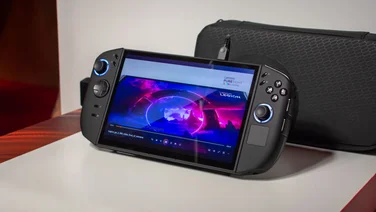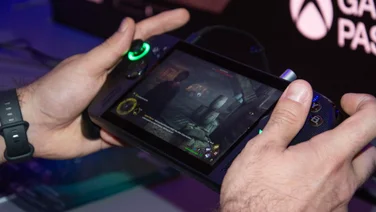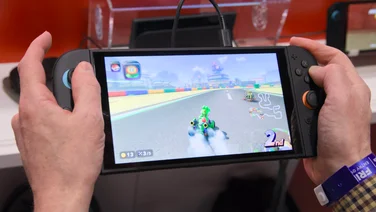To help us provide you with free impartial advice, we may earn a commission if you buy through links on our site. Learn more
- Best VR headset: At a glance
- How to choose the best VR headset for you
- How we test VR headsets
- The best VR headsets you can buy
- 1. Oculus/Meta Quest 2: Best (wireless) VR headset
- 2. HTC Vive Pro 2: Virtual reality like no other
- 3. PlayStation VR: Best (and only) VR headset for PS4
- 4. HTC Vive Cosmos: Best Oculus Rift S alternative

Looking to spice up your gaming life with one of the best VR headsets around? As the VR market continues to expand and the metaverse evolves from confusing concept to (virtual) reality, it’s definitely a savvy choice – but choosing the best VR headset for you can be a virtual nightmare. Some premium VR headsets will set you back hundreds, and to even use them you’ll need to be tethered to a high-performing PC; On the flip side, there are also VR headsets that cost under £50 and only require a smartphone to run.
In addition to the luxury VR headsets from big-hitters Oculus (or Meta, as it will henceforth be known), Valve and HTC, there’s a slew of lesser-known products from manufacturers like Pimax, Zeiss and even HP. Each year brings new possibilities to the VR market – take the new Oculus/Meta Quest 2, which is currently the best VR headset around (wireless or otherwise). And then there’s Sony’s PSVR and Nintendo’s Labo VR, which brought virtual reality console gaming to the masses.
There are always numerous VR headset releases on the horizon, but this article features the best headsets available right now – plus a handy buying guide to help you choose the right one.
Best VR headset: At a glance
| Best (wireless) VR headset | Oculus/Meta Quest 2 | From £400 | |
| Virtual reality like no other | HTC Vive Pro 2 | £779 | |
| Best VR headset for PS4 | Playstation VR | £111 | |
| Best Oculus Rift S alternative | HTC Vive Cosmos | £550 |
How to choose the best VR headset for you
What type of VR headset should I buy?
That’s right: You don’t have to spend your life savings on a gaming PC to enjoy VR. Here are the various types of headsets you might want to consider:
PC VR headset: If you already own a gaming PC, a PC VR headset is an obvious choice. You’ll have access to Steam’s ever-growing library of VR games, alongside the libraries of either Oculus or HTC (if you opt for one of their products).
PC VR headsets offer the best displays in the industry, with high refresh rates and resolutions for a more immersive experience. You will need to check that your PC can run VR games before you buy, however – you can do that using Steam’s VR benchmark test.
Mobile VR headset: If you just want something to keep your kids/spouse/colleagues entertained, a mobile VR headset is the way to go. Available from as little as £25, these headsets are really just goggles with weird lenses – you’ll need to supply the hardware in the form of a compatible smartphone. Download the relevant app, stuff the phone into the slot behind the lenses and you’re ready to go.
Wireless VR headset: Wireless VR is still in its infancy, but that doesn’t mean you should discount it – quite the opposite, in fact. It’s a bit of a compromise: the visual experience and game library is a tad less impressive than that of PCVR, but you won’t need any extra gadgetry to get started. Perfect for newcomers interested in something serious.
Console VR headset: There are VR headsets (or VR experiences) available for both PlayStation and Nintendo fans – if you’re an Xbox owner, I’m afraid you’re out of luck. You’ll find that the type of VR experience is limited by the power of the console; Sony’s PSVR is almost as impressive as full-blooded PCVR, where Nintendo’s Labo kits are closer to mobile VR. Both are reviewed here.
What specs should I look out for?
Display resolution: VR headset resolutions are measured both as a whole unit, and on a per-eye basis. Modern PCVR headsets tend to have a combined display resolution of at least 2,560 x 1,440, or 1,280 x 1,440 per eye – the higher the resolution, the clearer the image, and the more you will have to pay (usually).
Display type: You won’t need to worry too much about this, but for reference, most PCVR manufacturers are moving to fast-switch LCD panels and leaving OLED displays in the dust. This is because OLEDs are expensive, and produce a blurrier image than LCDs.
Refresh rate: This determines how many new images the display can show in a second (measured in Hz). Fundamentally, a high refresh rate means the moving image you’re seeing on-screen will appear smoother, and you might therefore feel less nauseous. Expect refresh rates to vary from 70-120Hz.
FOV: Field of Vision – how much of the virtual world you can see when peering into the lenses of your HMD. Most VR headsets have a FOV of around 100-110 degrees, which is just barely enough to make you feel like you’re inside the world, rather than just looking at a screen.
READ NEXT: The best controllers to use on PC
What’s the difference between virtual reality, augmented reality and mixed reality?
If you’re a newcomer to VR, you will probably have seen or heard the phrases above. But what exactly do they mean?
Virtual reality: Peering into a specially designed pair of goggles that display a 3D CGI environment that you can interact with using wand-like controllers (or in some cases, your hands).
Augmented reality: Layering computer-generated graphics on top of real-world image capturing technology. If you’ve ever played Pokemon Go, you’ve experienced augmented reality (through the lens of your smartphone).
Mixed reality: A combination of VR and AR. Mixed reality takes the concept of AR – layering CGI over the real world – and improves upon it by enabling more complex interactions between the virtual and the real.
Confused? Don’t be. Every product on our list is a good old-fashioned virtual reality headset. You’ll find that headsets with the “Windows Mixed Reality” label have been discontinued – but if you do happen across one that’s available to buy, know that it’s just a VR headset with support for Microsoft’s own VR software.
What about the rest of the jargon?
HMD: Head-Mounted Display – The catch-all term for the VR headset itself, excluding any peripherals.
Base stations: Small-ish sensors that track the movement of both the HMD and the motion controllers. Some VR headsets require you to set up a few base stations around the room you intend to play in.
Inside-out tracking: Rather than using base stations, it’s becoming more common these days for VR headsets to be dotted with cameras that track your movement, and the movement of your controllers. This is called inside-out tracking, and it’s really great: base stations are space-consuming and a pain to set up.
IPD slider: Inter-Pupillary Distance slider – a physical or virtual slider that allows you to widen or shrink the gap between the two lenses inside the HMD. After all, some of us have bigger heads or wider-set eyes than others.
Sweet spot: The area right in the centre of the lens that affords the clearest view of the display itself. The larger the sweet spot, the better.
Screen-door effect: This is when you can see the individual pixels of your headset’s display, arranged in a grid that overlays the image. It’s an unfortunate side-effect of the current limitations of VR technology; the higher the resolution of the display, the less visible the screen-door effect is.
What on earth is the metaverse?
When Facebook announced that it would be rebranding to “Meta”, it also revealed that it would be expanding into something called the metaverse in a major way. In the accompanying Tweet, Facebook-now-Meta described the metaverse in the most understandable manner we could find: “a place where we’ll play and connect in 3D”.
At its core, that’s all the metaverse is: any collaborative virtual environment accessed via a VR headset like the Oculus/Meta Quest 2. Applications that fall under the metaverse umbrella have actually been around for a while now: VRChat and Rec Room allow users to don a headset, create an avatar and jump into a virtual world shared by others where they can play games, hang out or just sit and marvel at the scenery.
Follow this particular thread to its destination and you might imagine something like Ready Player One, where the metaverse is a thriving world complete with a functioning economy and social classes. While it’s true that several companies are buying up virtual real estate in the metaverse, however, we’re a little way off the dystopian future Cline imagines in his novel.

Editor's pick | Oculus/Meta Quest 2
Unless you own a high-end gaming PC, the absolute best way to experience VR is via the magnificent Oculus (now Meta) Quest 2. This portable VR headset is the most accessible way to enjoy the likes of Beat Saber and Superhot we've ever tested. It isn't perfect (you will need a Facebook account to play) but it's the best VR headset for most people.
How we test VR headsets
We’ve tested every VR headset on this page (and many more besides). Testing a VR headset requires exploring every single nook and cranny, trying out the features on offer and pushing the technology to its limits. We’ll start by setting it up: this can be a laborious process, especially if the headset is wired. It’s a chance to test how user-friendly the headset is and whether you’ll need to be competent with a PC.
Screen testing requires constant comparison. We’re looking at how noticeable the screen door effect is; how large the sweet spot is; and how the panel’s colour reproduction and brightness stacks up against rivals. We’ll experiment with the virtual/physical IPD adjuster and the passthrough cameras if we can.
Most other aspects of a VR headset can be tested while using it to game or consume other media. Frantically swinging a lightsaber around in Vader Immortal, for example, will reveal how well the headset tracks its controllers/your hands. We’ll try a number of games based on what’s available to us, using the headset in as many different ways as it will allow (that is, both wirelessly and/or connected to a PC or console) and trying other forms of media such as TV or immersive experiences if they’re provided. Using the headset for elongated periods of time lets us judge how heavy and comfortable it is and how badly it cooks your face. And of course, we can test the battery life of wireless headsets simply by letting the battery drain from full over the course of a testing session and recording the time taken.
The best VR headsets you can buy
1. Oculus/Meta Quest 2: Best (wireless) VR headset

Price when reviewed: From £400 | Check price at Amazon
Read no further: the Oculus (now Meta) Quest 2 is the only VR headset you need. It builds upon the unexpected success of the Oculus Quest in pretty much every way, but if we had to pick a stand-out improvement, it would be the £100 Oculus (Meta) has managed to shave off the price.
And that’s without compromising on the hardware front. By slotting in a new processor and increasing the available memory, Oculus (Meta – this is getting tiring) has drastically improved the performance of the Quest 2, opening the door for more ambitious VR games. Not that existing titles are left wanting: courtesy of a gorgeous near-4K LCD panel refreshing at a smooth 90Hz, games and other experiences look better than anything we’ve tested before.
The Quest 2 is also smaller and lighter than its predecessor and uses a fabric strap to stay very firmly attached to your face. Of course, it isn’t without faults: adjusting the distance between lenses (to match your eyes) is a fiddly process and, perhaps more contentiously, new users will need to sign in using a Facebook (Meta!!) account – although this is set to change at some point in 2022. To be blunt, this is entirely for the data-tracking benefits, so we urge new users to take a good look at the privacy settings.
If these things don’t dissuade you, there’s no simpler way to put it: the Quest 2 is the best VR headset around.
Read our full Oculus Quest 2 review for more details
Key specs – Display resolution: 3,664 x 1,920; Display type: Fast-switch LCD; Refresh rate: 90Hz; Field of View: N/A; Supported software: Oculus Home; Dimensions: 191.5 x 102 x 295.5mm; Weight: 503g
2. HTC Vive Pro 2: Virtual reality like no other

Price when reviewed: From £779 | Check price at Vive
It’s no surprise that the most expensive VR headset on this list is also the most fully featured. It’s not cheap, not by any stretch of the imagination, but the Vive Pro 2 benefits from a handful of exclusive, game-friendly features that you won’t find anywhere else.
To begin with, the Vive Pro 2’s display is the highest resolution we’ve ever seen on a commercial VR headset, with a boosted total resolution of 4,896 x 2,448 (2,448 x 2,448 per eye). It also now supports a maximum 120Hz refresh rate, as well as a wider 130-degree FOV. Provided your accompanying PC is powerful enough to meet the minimum spec requirements, then there’s absolutely nothing better for virtual reality gaming at the moment. Games like Half-Life: Alyx never looked so good.
The only reason it misses out on taking the top spot is due to its high price. For most, the Quest 2 is good enough, but if you’re hoping to push VR to its very limits, then the Vive Pro 2 offers a virtual reality experience unlike any other.
Read our full HTC Vive Pro 2 review for more details
Key specs – Display resolution: 4,896 x 2,448; Display type: Dual RGB low-persistence LCD; Refresh rate: 120Hz; Field of View: 120-degree; Supported software: Viveport, SteamVR; Dimensions: 348 x 194 x 344mm; Weight: 850g
3. PlayStation VR: Best (and only) VR headset for PS4

Price when reviewed: From £111 | Check price at Amazon
If games are your thing, you can’t do much better than the PlayStation VR. Anyone with a PlayStation 4 can pick one up and dive straight in, and Sony’s headset has a library full of brilliantly fun VR games that offer up short bursts of fun or perfect lengthy playthroughs. It’s also the only way to scare yourself silly with Resident Evil 7 in VR.
It’s certainly not the most feature-filled headset on the market – especially compared to the HTC Vive or Oculus Rift – but with almost one million sales in its opening months, Sony has clearly got the price-to-performance ratio almost perfect. Obviously, the PS4 isn’t the most recent PlayStation console on the block these days but fortunately, the original PSVR is fully compatible with the PS5. Sony has officially announced that PS VR2 is coming soon, however, so you might want to hold off if you’re the proud owner of a next-gen Sony console.
Read our full PlayStation VR review for more details
Key specs – Display resolution: 1,920 x 1,080; Display type: OLED; Refresh rate: 120Hz; Field of View: 100 degrees; Supported software: PlayStation VR titles; Dimensions: 187 x 185 x 277mm; Weight: 610g
4. HTC Vive Cosmos: Best Oculus Rift S alternative

Price when reviewed: £550 | Check price at Amazon
The HTC Vive Cosmos is an incredibly well-specced HMD. With a combined display resolution of 2,880 x 1,700 (1,440 x 1,700 per eye), it tops the charts in terms of screen quality, beating its predecessor the Vive Pro, and only falling short of the £900 Valve Index and the £300 Oculus Quest 2. This penchant for the premium extends to all corners of the Cosmos: the build is sturdy, and the visor, more comfortable than that of any headset on this list. The addition of built-in tracking cameras, meanwhile, vastly simplifies the setup.
It’s by no means a perfect headset, however. The Cosmos still suffers from a few niggling flaws, not least of which is the bloated price tag. The Cosmos controllers are unwieldy, and the lenses have a pitifully small sweet spot, so you will notice strong blurring if you move your eyes from the centre of the image. HTC’s Viveport user interface, moreover, is far less polished than the Oculus or Steam equivalents.
This is a VR headset for HTC loyalists, particularly those who already own additional base stations and/or the Vive Pro controllers (the Cosmos can take advantage of both). It’s also for those who want a headset that sits between the very traditional HTC Vive Pro 2 and the user-friendly Oculus Quest 2 – a spot no longer filled by the esteemed and dearly departed Oculus Rift S.
Read our full HTC Vive Cosmos review for more details
Key specs – Display resolution: 2,880 x 1,700; Display type: LCD; Refresh rate: 90Hz; Field of View: 110 degrees; Supported software: Viveport, Steam VR; Dimensions: N/A; Weight: 645g











